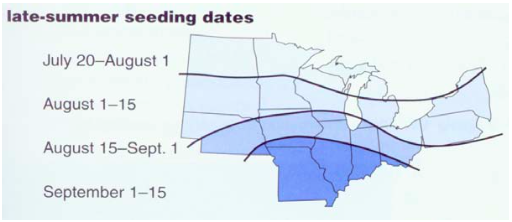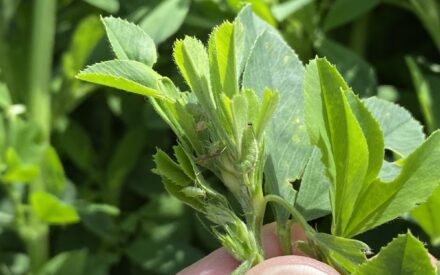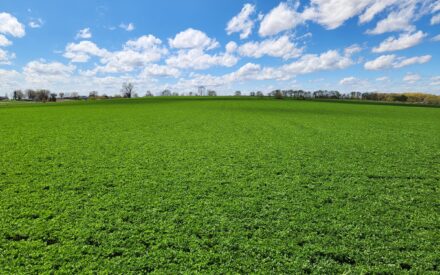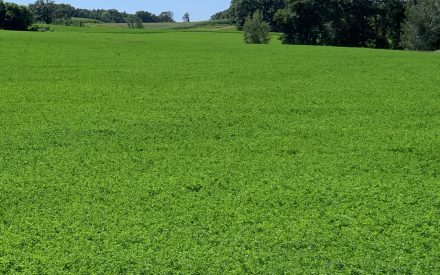Late summer seeding is an excellent way to establish stands and is actually the preferred time of year to seed in many regions. But your decision to late summer seed should be based on weather conditions (temperature), available soil moisture, and your projected forage needs (importance of having a fully productive alfalfa stand available next spring vs. direct seeding).

Advantages
- Allows seeding of alfalfa following the summer harvest of small grains, vegetable crops or sweet corn.
- Increased first year yield compared to spring seeding.
- Weeds are primarily controlled by pre-plant cultivation or burn down, reducing the need for herbicides.
- More time available for proper seedbed preparation.
Disadvantages
- Shortage of moisture and/or extreme high temperatures may result in reduced stand density.
- If too dry at seeding time, seed may germinate too late to get enough growth to survive the winter.
- Frost damage may occur if recommended planting dates are not followed or early frost occurs.
- Herbicide carryover may cause stand losses.
Recommendations
- Plant only if conditions right
- Never seed into dry soil – a light rain (1⁄2 inch or less) can germinate seed, but the new seedling will die from drought in a matter of days if no more rain is received.
- Weeds must be controlled prior to seeding.
- Plant at Proper Date
- Next to dry soil, planting too late is the biggest cause of summer seeding failures.
- Actual dates will vary based on moisture availability and temperatures. Must get at least 45 frost-free days of good growing conditions after seeding to build up adequate carbohydrate reserves for winter.
- Alfalfa Autotoxicity
- Alfalfa plants produce a toxin that can reduce root development and survival of new seedlings.
- If reseeding into a previous alfalfa stand, a waiting period is needed to allow toxin to degrade out of root zone. You can reseed immediately into a failed spring seeding (or from the previous fall). If alfalfa stand is two or more years old we recommend waiting 2 years before reseeding.
- Fertility
- Have soil tested and follow lime and fertilizer recommendations for potassium, phosphorus, boron, and sulfur.
- Optimum pH level is 6.8. Liming should be done 6 to 24 months prior to planting.
- Phosphorus is critical to proper root and seedling development. Potassium increases yields and stand persistence.
- Fields with high available nitrogen levels may delay or prevent the formation of nodules.
- Seed Bed Preparation
- Tillage is important to control perennial weeds prior to seeding, but do not dry out soil by over-tilling.
- Soil firmness is critical to insure proper soil-to-seed contact and preserve soil moisture. Pack soil before and after planting for best results
- If seeding into stubble, make sure you have good soil-to-seed contact and proper planting depth.
- Seeding Methods
- The same seeding rates and methods are recommended for late summer as for spring seedings.
- Seeders need press wheels or you need a cultipacker to optimize seed-to-soil contact for fast establishment.
- No-till seeders should have heavy down pressure, coulters ahead of disk openers, disk openers with depth control mechanism and press wheels.
- Planting Depth
- Ideal planting depth is 1/4-inch – do not plant seed deeper than 1/2-inch
- Pre-pack soil firmly to control depth of seed – especially critical if soil is dry.
- Weed Control
- Use a burn-down herbicide, such as Touchdown or Roundup, before planting to control perennial weeds and destroy any remaining vegetative growth from the previous crop.
- Do not use a cover crop with late summer seedings as it slows alfalfa establishment and may out-compete alfalfa for critical moisture.
- If weeds (like volunteer wheat) infest the newly seeded stand, contact your agronomist for recommended post emerge herbicides. Clipping to reduce weed competition should be avoided with fall seedings.
- Post-Seeding Considerations
- Avoid harvesting alfalfa the fall of seeding unless you have no other feed options. Fall harvesting or grazing of summer seeding will most likely result in stand losses over the first winter, reducing long-term productivity.
- If feed is needed, cut after alfalfa plants have gone into dormancy.
- If significant weed competition is present in the spring, use herbicides to clean up field as early as possible.
- Variety Selection Criteria
- Plant alfalfa varieties with high genetic potential for yields, quality, persistence and the pest resistances you will need for maximum long-term performance from your alfalfa stand.
- Disease Resistance – R or HR at all major alfalfa diseases in your area. Seedling diseases are not as important in late summer seeding as for spring seeding, but major diseases are still key factors for persistence.
- Winterhardiness – Varieties with low winter survival score (less than 2) and high resistance to root and crown diseases are your best choice for winter survival.
- Plant alfalfa varieties with high genetic potential for yields, quality, persistence and the pest resistances you will need for maximum long-term performance from your alfalfa stand.
In summary, late summer seedings have some risks, but offer many advantages for establishing strong, productive alfalfa stands to maximize your alfalfa yields and profitability. By following these guidelines, you can manage and/or reduce your risks and increase your success.


 ▶ Forage Insect Pest Update
▶ Forage Insect Pest Update ▶ Determining the Value of Standing Forage
▶ Determining the Value of Standing Forage First crop insect scouting in alfalfa
First crop insect scouting in alfalfa


